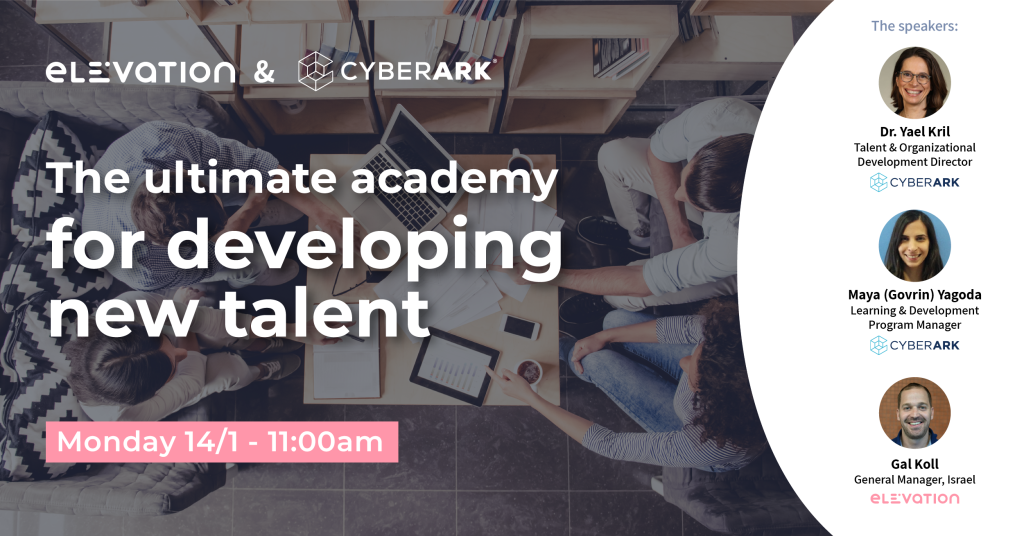In-house training has become the hottest buzzword these days in HR and L&D. To enjoy organizational growth, recruiting talented employees needs to be a top priority, even if the efforts, resources, and investment in searching for them are great, long and often expensive. In a special webinar we had in collaboration with CyberArk – a leading organization providing solutions in identity security and access management, we shared the process of establishing the U-Code Academy for training the next generation of CyberArk developers: starting with the need for which the training academy was established, going through the difficulties along the way, and the many benefits of having a new generation entering the organization, bringing fresh energy with them.
Why do we need to establish a training academy in the first place?
Usually, we’ll establish an employee training program as a recruitment solution for the talent we all want to recruit, but are a little weary of the competition on them. In pursuing “the talents”, we have somewhat forgotten that many people have enormous potential to succeed. With the right investment, it is possible to find these potential workers, and turn them into talents that will fit your organization like a glove.
This is exactly what CyberArk did when they reached a crucial point in recruiting a large number of developers, as they identified “a golden opportunity to freshen up the organization’s DNA by providing diverse populations to enter the organization,” according to Dr. Yael Kril – CyberArk’s Talent and Organizational Development Director.

The process of implementing corporate training for new talents:
First, understanding all the variables, parties, and resources you have:
For the process of creating an academy, you need the right partners to cooperate with, partners who understand the required investments, and utilize the resources at your disposal. All this, with a deep understanding and analysis of the very needs in which such a program can help deal with the challenges you may face.
Dr. Krill shares, “When Covid-19 was at its peak, we experienced a dramatic business acceleration for CyberArk’s products due to cyber threats that increased at that time. Meanwhile, the organization was moving from a physical product, to one that is cloud-based. This business transformation required us to bring new blood into the system and look at things with fresh eyes on developing the new product and its new team.”
Instead of asking many questions, try to be as precise as possible. The narrower the issue, the easier it is to find solutions or answers and gather the data you need.
Defying the challenges facing us:
In CyberArk’s case, their main challenge was massive hiring in a short amount of time. “The change required us to do things completely differently,” says Dr. Krill. We took this opportunity to hire potential talents from different groups who don’t necessarily fit 100% of our DNA, like juniors, younger employees, people on the autistic spectrum, more women and veterans of combat units, not just graduates of unit 8200.”
The target was clear – Bring new people, connect them to the organization and its values, provide them with all the knowledge in the cyber world and create a new group of developers to “rejuvenate” the business. Gal Koll – General Manager, Elevation Israel, “Something we see in other places is that today’s generation moves relatively quickly between workplaces, creating themselves a portfolio of “mini-careers”. Therefore, when an organization comes and declares its faith in people who might not have the full knowledge required to fill a position, it retains them for a longer time in the organization.” A big win for both sides.
The task – cut in half the current training period:
The average time until a junior becomes productive for the organization is about four full months. The task at U – Code Academy was to shorten this time in half and, hence, cut training and onboarding costs accordingly. The bonus here is the ability to crunch the process into measurable data for future ROI reports and show management the tremendous benefits of developing on-the-job training programs.
Creating collaborations in characterizing the organization’s needs:
When conversing with all the relevant parties from the learning, recruitment, and development departments, you must agree on the important issues before starting. “You need to understand the practical abilities a junior should possess at the end of the training. You need to engage in a conversation between the development and learning teams to understand their needs and how to meet them. Only then can you start building a training boot- camp and its content syllabus,” explains Dr. Krill.
Dealing with management:
“To sway and change an organization’s cultural perspective, we need the pilot to excel and for the applicants to fully commit to the process,” Krill explains. “We needed to handle some fixed questions from management. It was clear that if we didn’t get the green light for the project, we wouldn’t experience organizational growth. Therefore, our first task was to find those two-three managers to give us the GO we needed, and once we did, the program started to take shape”.
Defining, sorting, and screening potential tech talent:
As part of Elevation’s work, we perform a strict screening process to find the most suitable candidates for the academy. The process includes: refining the job description and the skills needed for it, defining the right syllabus to meet the organization’s needs, producing and developing missing content, establishing digital assets, and everything that happens from there until the end of the program including generating learning and insights reports.
Since CyberArk hires the selected applicants as company employees from day one, it was important to set some harsh acceptance conditions. “Many companies say ‘let’s do a full-stack program! We will fund the training, but ultimately we will choose the outstanding ones and hire only them’. We work the other way around – to get the desired talents, we will hire the trainees from day one as our employees. We need to provide a feeling that we believe in them. We want them to be part of the team out of a mutual belief that they will want to stay with us after the training ends and not get up and leave” explains Dr. Krill.
And what was the outcome?
Elevations’ thorough screening process allows the best to join the program. Within three weeks, we received over 1,000 applications. Roughly 25% of them moved to the next stage – a technical-professional test to examine their abilities. Then, 10% moved to the 3rd step, filming a personal video designed to test their motivation and level of English. Then, 4% continued to the personal-professional screening day at the organization’s headquarters, and finally – only 2% were accepted to the training program (22 new employees).
The academy program works in a hybrid method – two days in the office and three days from home. The new employees are paid from day one to increase their motivation and connection to the organization, while being accompanied by development, recruitment, and training team mentors. The new employees are measured at every stage during the academy to determine their final placement.
Those in the heart of the tech industry eventually recognize that critical thinking is a skill that can be a key to success. In other words, it allows us to make decisions & conclusions based on cognitive flexibility, which provides us with a wide range of perspectives, opinions, and information to consider.

Maya Govrin Yagoda – CyberArk’s Learning & Development Program Manager, provided us her highlights on enhancing the experience and the onboarding of the new employees:
Stay connected before the program starts: Send a small gift to their home, open a WhatsApp group, and hold meetings with the existing employees. “All of this helps connect the new recruits to the human fabric of the organization.”
Integrate content from existing employees: To share their experience, their role in the organization, tips, and more. “At the beginning of the academy, we had a session with a sales manager who explained the products, an HR session, and additional content that gave certainty for the future to come” says Maya.
On-hand management is the key to success: “On-hand management from our side also proved to be very important. Bring mentors, project managers, and other personnel who can assist in creating a connection, help, and support in times of need,” Maya explains.
Exposure to managers and professional teams: This way, on one hand, the participants will get to connect with the organization and its values, and on the other hand, the organization will lower its “defense walls” for hiring only experienced people at the organization.
Dr. Yael Karil says that she herself is a mother of a junior. “The introduction of juniors into the work sector is harsh. Therefore, the gift of a supporting system in a unified group where you have someone to pick up the phone, someone to vent to, someone to have lunch with or stay and study an extra hour – this is a winning formula for the sense of security and belonging to the organization. These are significant contributions to the new employee’s motivation to succeed.” Maya added that throughout the course, they examined the employees’ performance, strengths, and weaknesses to make the most accurate decision in placing them after the training ends.
To conclude, the benefits of a training academy for any organization are significant:
The academy is still in progress. We are at 13 weeks out of 16, and the program is already proving successful. We have hired 22 talented developers in a short time. We shortened the onboarding and training process to half the time while bringing “new blood” into the organization. We gave value to employees by being mentors, and we improved the perception of all employees (strong employer branding). We have created a supportive community and a new mindset of “Potential over Experience”. All these before we even finished training the new talents.
“It is important to have those who will confront us, ask difficult questions and do things with a new and refreshing point of view,” says Maya. But such a process takes effort, time, and resources. But most importantly – a partner who is even more committed to the goal than you. The process at CyberArk only proves that an external partner can assist and lead such a process within the organization, even if they are not an internal part of it.
If you are looking for partners for this kind of cooperation, we’re here.
Elevations’ training academy is the ultimate solution for hiring employees and training them to be the talents your organization needs.
So what are you waiting for?







